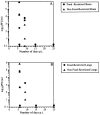Functional consequences following infection of the olfactory system by intranasal infusion of the olfactory bulb line variant (OBLV) of mouse hepatitis strain JHM
- PMID: 11595672
- PMCID: PMC7110209
- DOI: 10.1093/chemse/26.8.953
Functional consequences following infection of the olfactory system by intranasal infusion of the olfactory bulb line variant (OBLV) of mouse hepatitis strain JHM
Abstract
The present study assessed the functional consequences of viral infection with a neurotropic coronavirus, designated MHV OBLV, that specifically targets central olfactory structures. Using standard operant techniques and a 'go, no-go' successive discrimination paradigm, six BALB/c mice were trained to discriminate between the presentation of an air or odor stimulus (three mice for each of the odorants propanol and propyl acetate). Two additional BALB/c mice were trained to discriminate between the presentation of air and the presentation of either vanillin or propionic acid. Following criterion performance, each mouse received an additional 2000 trials of overtraining. At completion of overtraining one mouse from the propanol and propyl acetate groups were allocated as untreated. The remaining six mice were inoculated with 300 microl of the OBLV stock per nostril for a total of 1.5 x 10(6) p.f.u. in 600 microl. Following a 1 month rest, untreated and inoculated animals were again tested on their respective air versus odor discrimination task. Untreated animals immediately performed at criterion levels. In contrast, inoculated animals varied in their capacity to discriminate between air and odorant. Five of the six inoculated mice showed massive disruption of the olfactory bulb, including death of mitral cells; the other was more modestly affected. In addition, the density of innervation of the olfactory mucosa by substance P-containing trigeminal fibers is also affected by inoculation. Those mice that remained anosmic to the training odorants had the most severe reduction in mitral cell number and substance P fiber density among the inoculated animals.
Figures





Similar articles
-
Intranasal inoculation with the olfactory bulb line variant of mouse hepatitis virus causes extensive destruction of the olfactory bulb and accelerated turnover of neurons in the olfactory epithelium of mice.Chem Senses. 2001 Oct;26(8):937-52. doi: 10.1093/chemse/26.8.937. Chem Senses. 2001. PMID: 11595671 Free PMC article.
-
The olfactory nerve and not the trigeminal nerve is the major site of CNS entry for mouse hepatitis virus, strain JHM.Virology. 1993 May;194(1):185-91. doi: 10.1006/viro.1993.1248. Virology. 1993. PMID: 8386871
-
Olfactory neural pathway in mouse hepatitis virus nasoencephalitis.Acta Neuropathol. 1988;76(5):502-6. doi: 10.1007/BF00686390. Acta Neuropathol. 1988. PMID: 2847476 Free PMC article.
-
In vivo visualization of olfactory pathophysiology induced by intranasal cadmium instillation in mice.Neurotoxicology. 2011 Aug;32(4):441-9. doi: 10.1016/j.neuro.2011.03.007. Epub 2011 Apr 2. Neurotoxicology. 2011. PMID: 21443902 Free PMC article.
-
Mouse hepatitis virus and herpes simplex virus move along different CNS pathways.Adv Exp Med Biol. 1993;342:313-8. doi: 10.1007/978-1-4615-2996-5_48. Adv Exp Med Biol. 1993. PMID: 7516106
Cited by
-
The temporal course of COVID-19 anosmia and relation to other clinical symptoms.Eur Arch Otorhinolaryngol. 2021 Jun;278(6):1891-1897. doi: 10.1007/s00405-020-06496-5. Epub 2020 Nov 25. Eur Arch Otorhinolaryngol. 2021. PMID: 33237475 Free PMC article.
-
COVID-19 anosmia and gustatory symptoms as a prognosis factor: a subanalysis of the HOPE COVID-19 (Health Outcome Predictive Evaluation for COVID-19) registry.Infection. 2021 Aug;49(4):677-684. doi: 10.1007/s15010-021-01587-9. Epub 2021 Mar 1. Infection. 2021. PMID: 33646505 Free PMC article.
-
Non-neuronal expression of SARS-CoV-2 entry genes in the olfactory system suggests mechanisms underlying COVID-19-associated anosmia.Sci Adv. 2020 Jul 31;6(31):eabc5801. doi: 10.1126/sciadv.abc5801. Epub 2020 Jul 24. Sci Adv. 2020. PMID: 32937591 Free PMC article.
-
A Systematic Review of the Neuropathologic Findings of Post-Viral Olfactory Dysfunction: Implications and Novel Insight for the COVID-19 Pandemic.Am J Rhinol Allergy. 2021 May;35(3):323-333. doi: 10.1177/1945892420957853. Epub 2020 Sep 11. Am J Rhinol Allergy. 2021. PMID: 32915650 Free PMC article.
-
Potential pathogenesis of ageusia and anosmia in COVID-19 patients.Int Forum Allergy Rhinol. 2020 Sep;10(9):1103-1104. doi: 10.1002/alr.22593. Epub 2020 Jun 15. Int Forum Allergy Rhinol. 2020. PMID: 32342636 Free PMC article. Review. No abstract available.
References
-
- Burd, G.D. (1993) Morphological study of the effects of intranasal zinc sulfate irrigation on the mouse olfactory epithelium and olfactory bulb Microsc. Res. Technol.,24 , 195-213. - PubMed
-
- Doty, R.L. (1975) Intranasal trigeminal detection of chemical vapors by humans Physiol. Behav.,14 , 855-859. - PubMed
-
- Doty, R.L., Brugger, W.E., Jurs, P.C., Orndorff, M.A., Snyder, P.J. and Lowery, L.D. (1978) Intranasal trigeminal stimulation from odorous volatiles: psychometric responses from anosmic and normal humans Physiol. Behav., 20,175 -185. - PubMed
-
- Evans, A.S. and Kaslow, R.A. (1997)Viral Infections of Humans: Epidemiology and Control , 4th edn. Plenum Publishing, New York, NY.

